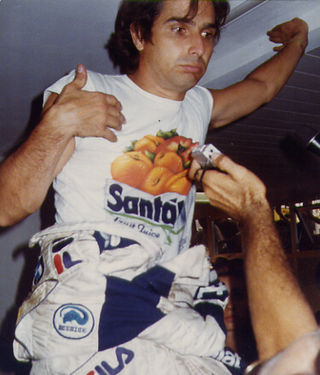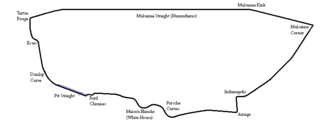
The German automobile manufacturer/brand BMW has been involved in Formula One in a number of capacities since the inauguration of the World Drivers' Championship in 1950. The company entered occasional races in the 1950s and 1960s, before building the BMW M12/13 inline-four turbocharged engine in the 1980s. This engine was the result of a deal between BMW and Brabham, which resulted in the team's chassis being powered by BMW engines from 1982 until 1987, a period in which Nelson Piquet won the 1983 championship driving a Brabham BT52-BMW. BMW also supplied the M12/13 on a customer basis to the ATS, Arrows, Benetton and Ligier teams during this period, with various degrees of success. In 1988, Brabham temporarily withdrew from the sport and BMW withdrew its official backing from the engines, which were still used by the Arrows team under the Megatron badge. Turbocharged engines were banned by the revised Formula One Technical Regulations for 1989, rendering the M12/13 obsolete.

The 1986 Austrian Grand Prix was a Formula One motor race held at Österreichring on 17 August 1986. It was the twelfth race of the 1986 Formula One World Championship.

The 1987 FIA Formula One World Championship was the 41st season of FIA Formula One motor racing. It featured the 1987 Formula One World Championship for Drivers and the 1987 Formula One World Championship for Constructors, which were contested concurrently over a sixteen-race series that commenced on 12 April and ended on 15 November.
Osella is an Italian racing car manufacturer and former Formula One team. They participated in 132 Grands Prix between 1980 and 1990. They achieved two points finishes and scored five world championship points.
Teodorico "Teo" Fabi is an Italian former racing driver, who competed in Formula One from 1982 to 1987. In sportscar racing, Fabi won the World Sportscar Championship in 1991 with Jaguar.

Zakspeed is a motor racing team from Germany, founded in 1968 by Erich Zakowski and then run by his son Peter Zakowski. It is based in Niederzissen, Rhineland-Palatinate, around 25 kilometres (16 mi) from the Nürburgring circuit.

Johnny Alberto Cecotto Persello, better known as Johnny Cecotto, is a Venezuelan former professional Grand Prix motorcycle racer and auto racer. He rose to prominence as a teenage prodigy in 1975 when he became the youngest motorcycle road racing world champion at the age of 19. Despite the auspicious beginning to his motorcycle racing career, he suffered numerous injuries and mechanical problems which curtailed his success in motorcycle Grand Prix racing.
Onyx Grand Prix is a former Formula One constructor from Britain that competed in the 1989 and 1990 Formula One seasons. The team participated in 26 World Championship Grands Prix and scored six World Constructors' Championship points. Its best result was third place, in the 1989 Portuguese Grand Prix, for Stefan Johansson.
Toleman Motorsport was a Formula One constructor based in the UK. It was active between 1981 and 1985 and participated in 70 Grands Prix.
March Engineering was a Formula One constructor and manufacturer of customer racing cars from the United Kingdom. Although only moderately successful in Grand Prix competition, March racing cars enjoyed much better success in other categories of competition, including Formula Two, Formula Three, IndyCar and IMSA GTP sportscar racing.

Throughout its history, BMW cars and motorcycles have been successful in a range of motorsport activities. Apart from the factory efforts, many privateer teams enter BMW road cars in touring car racing. BMW also entered cars or provided engines in Formula One, Formula Two and sportscar racing. BMW is currently active in IMSA, the Isle of Man TT, the North West 200, the Superbike World Championship and the Deutsche Tourenwagen Masters.

Gianfranco Brancatelli is a former racing driver from Italy.

The 1973 24 Hours of Le Mans was the 41st Grand Prix of Endurance and took place on 9 and 10 June 1973. It was the eighth round of the 1973 World Championship of Makes.

Porsche has been successful in many branches of motorsport of which most have been in long-distance races.

The 1985 James Hardie 1000 was a motor race held on 6 October 1985 at the Mount Panorama Circuit just outside Bathurst, in New South Wales, Australia. It was the 26th running of the Bathurst 1000 and was the first held exclusively for cars complying with the Australian version of International Group A touring car regulations. The event, which was organised by the Australian Racing Drivers Club Ltd, was Round Four of both the 1985 Australian Endurance Championship and the 1985 Australian Manufacturers' Championship.

The BMW M1 Procar Championship, sometimes known simply as Procar, was a one-make auto racing series which featured professional drivers from the Formula One World Championship, World Sportscar Championship, European Touring Car Championship, and other international series, using identically modified BMW M1 sports cars. It was created by Jochen Neerpasch, head of BMW Motorsport GmbH, the racing division of automobile manufacturer BMW.

The 33rd BRDC International Trophy was a Formula Two motor race held at Silverstone on 29 March 1981. It was the opening race of the 1981 European Formula Two Championship.
The 2020 Autobacs Super GT Series was motor racing championship based in Japan for grand touring cars. The series is sanctioned by the Japan Automobile Federation (JAF) and run by the GT Association (GTA). It was the twenty-eighth season of the Japan Automobile Federation Super GT Championship which includes the All Japan Grand Touring Car Championship (JGTC) era and the sixteenth season the series to compete under the Super GT name. It was the thirty-eighth overall season of a JAF national sportscar championship dating back to the All Japan Sports Prototype Championship.
The Honda RA260E is a four-stroke, naturally-aspirated, 2.0-liter, V6 racing engine, designed for Formula 2, which was built and developed by Honda Motor Co., Ltd, for Formula 2 racing, in 1980.
The Lola T850 is an open-wheel Formula 2 racing car from the British manufacturer Lola Cars, which was used in the European and Japanese Formula 2 Championships in the early 1980s. It is not Lola's own construction, but a car produced under a license that was developed by competing companies. A variant of the Lola T850 is the Docking Spitzley DS1. Lola also built a version destined for Formula Atlantic, sold as the Toleman TA860.












